= Astrophytum ornatum var. glabrescens (F.A.C.Weber) Y.Okomura
1933
Accepted Scientific Name: Astrophytum ornatum (DC.) F.A.C.Weber in Bois
Dict. Hort. [Bois] 1: 467. 1896 Bois
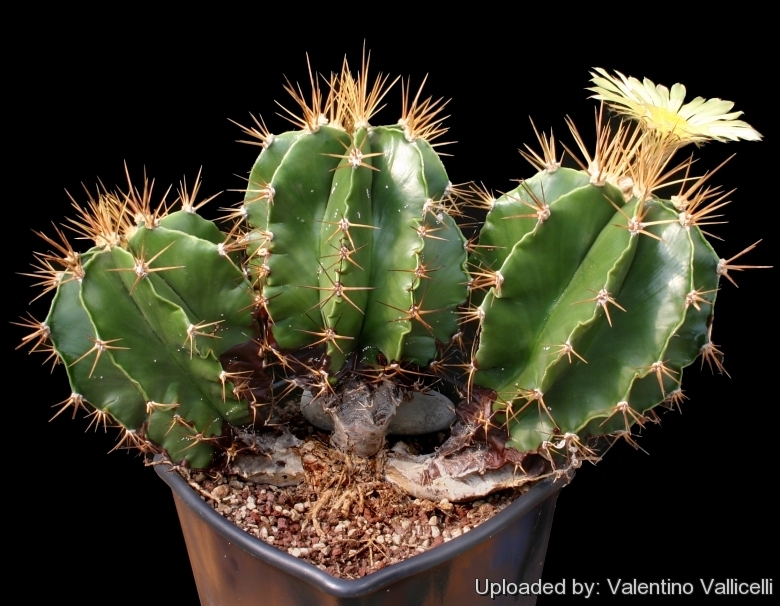
Astrophytum ornatum var. virens (Astrophytum ornatum var. glabrescens) Photo by: Valentino Vallicelli
Ribs are smooth and bright green. The flowers (6-8 cm wide) are pale yellow with bright silken sheen and scented.
Origin and Habitat: A. ornatum is the southern species of Astrophytum. The habitats are at Hidalgo, Queretaro and Guanajuato in Mexico.
Habitat: grows in wild canyons and limestone cliffs.
Synonyms:
See all synonyms of Astrophytum ornatum
back
Accepted name in llifle Database:Astrophytum ornatum (DC.) F.A.C.Weber in BoisDict. Hort. [Bois] 1: 467. 1896Synonymy: 23
Cultivars
(4):
back
Description: Astrophytum ornatumSN|3660]] is a shortly columnar cactus appearing star-shaped from above, often with white cross bands of woolly scales. It appears to be a very variable species especially for the density and distribution of white scales. It is the largest and easiest to grow and also the fastest of the astrophytums. It is also generally more heavily spined than other astrophytums.
Astrophytum ornatumSN|3660]] distinguishes for its stout almost naked dark green stem without (or with very few) white hair-tufts, on the contrary the white hair-tufts in typical plants are in broad bands, seeming to be hanging from opposing areoles and take a long time in the transition to the adult form. Up to date many botanists don’t recognize the variety rank to this taxon which does not differ conspicuously from the other forms of the species.
Stem: The stem is solitary, globose when young, cylindric with age, up to 1,2 m or more high, 15-30 cm across, dark green without (or with very few) wooly flakes.
Ribs: It has 5 to 8 (generally 8) straight or frequently spiraling, strongly compressed, more or less sinuate, crenate ribs.
Areoles: Rounded at first yellowish-white felted, later grabrescent.
Radial spines: 5-10 stout, 2-4 cm long straight acicular or somewhat laterally compressed, amber yellow, later brown and finally grey.
Central spines: Usually 1 rather larger.
Flowers: At apex, large, lemon-yelllow 7-12 cm broad, inner perianth segments broadly oblong, with a broad, more or less serrated apex, tube short woolly, scale on ovary, dark and very narrow.
Remarks: It needs to be at least 15 cm tall to bloom. This might take no less than seven years or more depending on the length of the growing period in the local climatic conditions.
Subspecies, varieties, forms and cultivars of plants belonging to the Astrophytum ornatum group
Bibliography: Major references and further lectures
1) James Cullen, Sabina G. Knees, H. Suzanne Cubey “The European Garden Flora Flowering Plants: A Manual for the Identification of Plants Cultivated in Europe, Both Out-of-Doors and Under Glass” Cambridge University Press, 11/Aug./2011
2) David Hunt, Nigel Taylor “The New Cactus Lexicon” DH Books, 2006
3) Edward F. Anderson “The Cactus Family” Timber Press, 2001
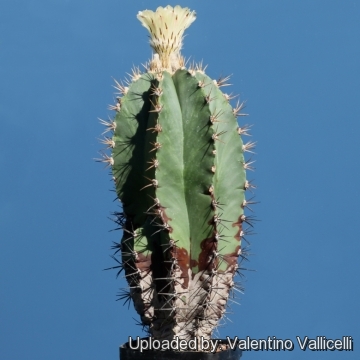 Astrophytum ornatum var. virens (Astrophytum ornatum var. glabrescens) Photo by: Valentino Vallicelli
Astrophytum ornatum var. virens (Astrophytum ornatum var. glabrescens) Photo by: Valentino Vallicelli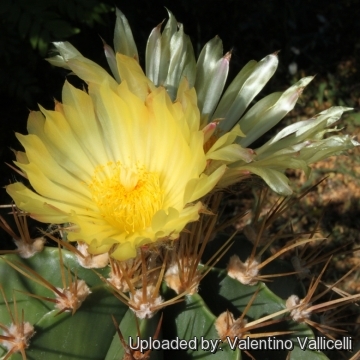 Astrophytum ornatum var. virens (Astrophytum ornatum var. glabrescens) Photo by: Valentino Vallicelli
Astrophytum ornatum var. virens (Astrophytum ornatum var. glabrescens) Photo by: Valentino Vallicelli Astrophytum ornatum var. virens (Astrophytum ornatum var. glabrescens) Photo by: Valentino Vallicelli
Astrophytum ornatum var. virens (Astrophytum ornatum var. glabrescens) Photo by: Valentino Vallicelli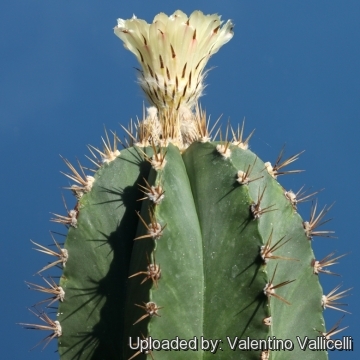 Astrophytum ornatum var. virens (Astrophytum ornatum var. glabrescens) Photo by: Valentino Vallicelli
Astrophytum ornatum var. virens (Astrophytum ornatum var. glabrescens) Photo by: Valentino Vallicelli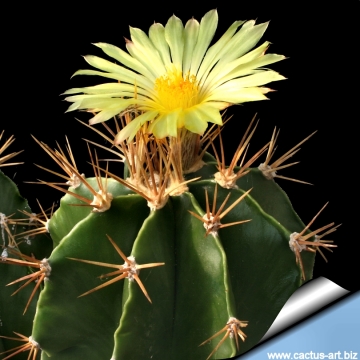 Astrophytum ornatum var. virens (Astrophytum ornatum var. glabrescens) Photo by: Cactus Art
Astrophytum ornatum var. virens (Astrophytum ornatum var. glabrescens) Photo by: Cactus ArtSend a photo of this plant.The gallery now contains thousands of pictures, however it is possible to do even more. We are, of course, seeking photos of species not yet shown in the gallery but not only that, we are also looking for better pictures than those already present.
Read More... Cultivation and Propagation: It is a popular summer-growing species of relatively easy cultivation.
Growth rate: Slow-growing. It needs to be at least 15 cm tall to bloom . This might take 7 to 12 (or more) years depending on the length of the growing period in the local climatic conditions.
Soil: Grow it in an open standard, sandy-gritty cactus compost and provide a very good drainage.
Exposure: It is suited for sunny-brightly exposure, but can tolerate light shade. However it will do its best with lots of sun and become stressed with inadequate light which could result in poor growth and unnatural shape. It has a good heat tolerance.
Watering: Water regularly (about once a week) during the growing season and keep it completely dry during winter or when night temperatures remain below 10° C. Water it less than average if in bigger pots.
Fertilization: Feed them once during the growing season with a fertilizer specifically formulated for cactus and succulents (high potash fertilizer with a dilute low nitrogen), including all micro nutrients and trace elements diluted to ½ the strength recommended on the label. They thrive in poor soils and need a limited supplies of fertilizer to avoid the plants developing excess vegetation, which is easily attacked by fungal diseases.
Special need: It is suited for airy exposures. Provide very good ventilation. Nearly all problems occur as a result of overwatering and poor ventilation, especially when weather conditions are dull and cool or very humid. ere.
Hardiness: It likes warmth (recommended minimum winter temperature 5° C) But plants kept perfectly dry can easily survive to light frost (it is reported hardy to -12 ° for brief periods).
Pests & diseases: These cacti may be attractive to a variety of insects, but plants in good condition should be nearly pest-free, particularly if they are grown in a mineral potting-mix, with good exposure and ventilation. Nonetheless, there are several pests to watch for:
- Red spiders: Red spiders may be effectively rubbed up by misting the plants from above.
- Mealy bugs: Mealy bugs occasionally develop aerial into the new leaves and flowers with disfiguring results, but the worst types develop underground on the roots and are invisible except by their effects.
- Scales, thrips and aphids: These insects are rarely a problem.
- Rot: Rot is only a minor problem if the plants are watered and “aired” correctly. If they are not, fungicides won't help all that much.
Propagation: It can be propagated easily from seed (seldom produces offsets). The seeds can be sown in pots of fine, well-drained sandy soil, any time during the spring when temperatures are warm. Cover the seeds with a fine layer of grit and water from below with a fungicide to prevent damping off. For the 1-2 weeks cover the pots with a sheet of glass/clear perspex to keep the humidity levels high. Remove the glass and replace it with light shade-cloth and mist once or twice a day for the next two weeks after which most seeds should have germinated. From then on mistings can be reduced to every second and then every third day as the little plants grow. The seedlings should not be disturbed until they are well rooted after which they can be planted separately in small pots. Sometimes it is grafted to avoid root rot problems as plants grafted on an hardy stock are easy to grow and no special skill is required.















